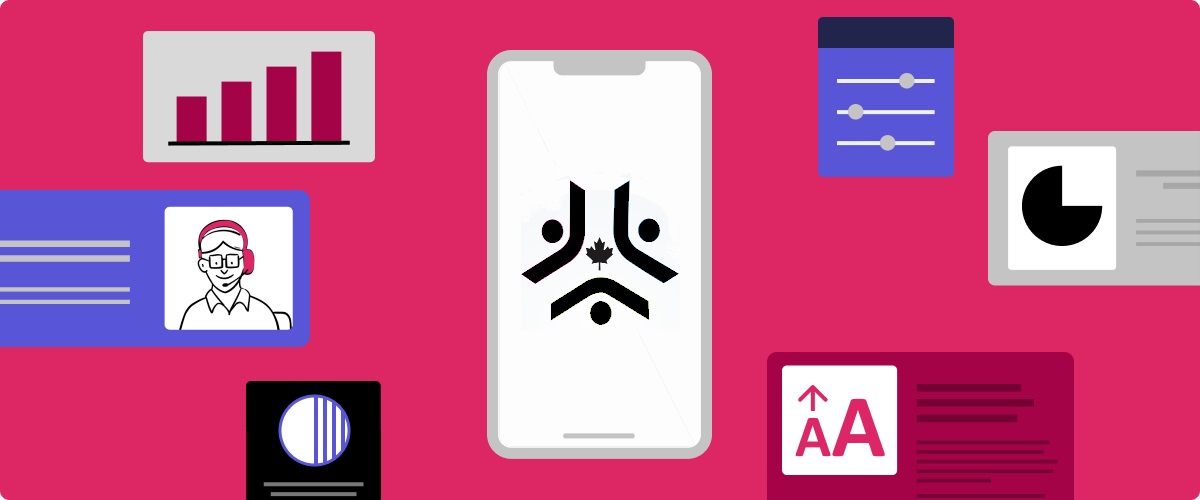
How Fable helps to meet your goals for the Accessible Canada Act’s three-year Accessibility Plan
The Accessible Canada Act is a law passed in 2019 by the Government of Canada. The goal is to make Canada barrier-free for people with disabilities by January 1, 2040.
Government organizations and private companies that service them must notify the Accessibility Commissioner, and publish a three-year Accessibility Plan on their website to meet the Act, by specific deadlines.

Meet your Accessible Canada Act goals
The Accessible Canada Act is a law passed in 2019 by the Government of Canada. The goal is to make Canada barrier-free for people with disabilities by January 1, 2040.
Government organizations and private companies that service them must notify the Accessibility Commissioner, and publish a three-year Accessibility Plan on their website to meet the Act, by specific deadlines.
What is a barrier?
A barrier is defined as anything that prevents people with disabilities from fully and equally participating in Canadian society. Barriers include digital products and services and the built environment around us. A more accessible society means making improvements to process and practices within business, education, entertainment, and government.

Who must follow the Act?
Organizations under federal responsibility must follow the Accessible Canada Act. This includes:
- federal government organizations like Canada Post and Employment and Social Development Canada
- banks and financial institutions
- airlines and public transportation
- telecommunications
- police and military, i.e., the Canadian Forces and the Royal Canadian Mounted Police
- certain Parliamentary entities, like the House of Commons or the Senate
What departments does the Accessibility Plan cover?
Ensure the accessibility of products, services, internal policies, processes, and practices in:
- information and communication technologies (ICT)
- employment
- the design and delivery of programs and services
- the procurement of goods, services and facilities
- communication, other than ICT
- transportation (if applicable)
- the built environment
Who must follow the Act?
Organizations under federal responsibility must follow the Accessible Canada Act. This includes:
- federal government organizations like Canada Post and Employment and Social Development Canada
- banks and financial institutions
- airlines and public transportation
- telecommunications
- police and military, i.e., the Canadian Forces and the Royal Canadian Mounted Police
- certain Parliamentary entities, like the House of Commons or the Senate
What departments does the Accessibility Plan cover?
Ensure the accessibility of products, services, internal policies, processes, and practices in:
- information and communication technologies (ICT)
- employment
- the design and delivery of programs and services
- the procurement of goods, services and facilities
- communication, other than ICT
- transportation (if applicable)
- the built environment
What does the Act require?
The Accessible Canada Act requires these organizations to prepare and publish a three-year Accessibility Plan. The plan outlines how they will identify, remove, and prevent barriers.
Organizations must:
- consult with people with disabilities as part of the plan
- assign someone in leadership to be responsible for meeting the plan
- publish full details of the plan on their website
- create a feedback channel (website, phone, email) for citizens to comment or suggest changes to the plan – and to highlight current barriers
- assign someone to monitor feedback and deliver it to the appropriate department
- create internal measures to show progress within the organization
- produce a progress report, including where any feedback received was incorporated
When and how to consult with people with disabilities
From 2016 to 2017, the Government of Canada consulted with 18 communities of people with disabilities, in-person and online to develop the Accessible Canada Act. The aim was to provide equal opportunity for Canadians with disabilities to participate in creating new laws and to include them in discussions about legislation that benefits them directly (and everyone).
After the consultation, it was evident that one of the most critical factors to advancing accessibility is the voice of end users.
Organizations are also required to consult persons with disabilities as part of the process of creating their Accessibility Plan.
Examples of consultation
- Information and communication technologies (ICT): gather feedback from end users on the accessibility and usability of a full list of ICTs including websites, web applications, mobile web, hardware and software, two-way communication audio devices, and ICT for emergency services, help desks and training services.
- Marketing & communications: engage users to validate that your downloadable materials, social media, blog posts, videos, and transcripts are accessible
- Human Resources: collect feedback from users navigating career sites, job postings, employment policies and workplace accommodation
- Procurement of goods and services: the importance of internal tool accessibility for success at work
- Design and delivery of all programs and services within the organization
People with disabilities can assist with building their needs into your Diversity, Equity and Inclusion (DEI) strategy.
More information on the Accessible Canada Act can be found on the Government of Canada website.
How Fable can help
Information and communications technology
Book user interviews with Fable’s community of assistive technology users to evaluate the accessibility and usability of your ICT properties and publish your average AUS scores.
Human Resources
Use compatibility tests or user interviews to evaluate your career site and job postings. Book user interviews to get insight in to the needs of people with disabilities for workplace accommodations and get feedback on your accessibility policies.

